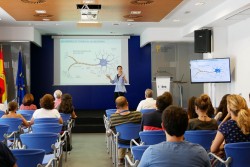FET projects shine at European Researchers’ Night 2018
Amazing things happened during the European Researchers’ Night 2018 (ERN2018), held 28-29 September 2018 in 27 European countries and beyond. ERN2018 saw the European Commission fund 55 projects promoted by the Marie Skłodowska-Curie Actions to raise public awareness of the role of researchers in society. Hands-on experiments, science shows, workshops for children and games are only a few examples of the activities that took place during these two days. In this framework, the activities proposed by Future and Emerging Technologies (FET) projects shone, captivating the attention of a large audience. One of these shining stars is the FET project AMECRYS that aims to revolutionise the downstream methods currently used in biopharmaceutical manufacturing, aimed at reducing the cost of anti-cancer drugs, for example. ERN2018 also saw, in the context of the SUPERSCIENCEME initiative funded by the Marie Skłodowska-Curie Actions, AMECRYS researchers of the University of Calabria engaging the audience by illustrating the basic techniques in membrane preparation and displaying the common tools used in their laboratory activity, while a web-video of the research was projected continuously to a wider online audience. A poster explaining general objectives, main activities and principal expected benefits of the project was illustrated by the researchers involved, and a brochure was distributed at the same time. Finally, laboratory visits were organized to illustrate general research activities. Over two days, approximately 50,000 people attended the ERN2018 events at the University of Calabria in southern Italy. At the same time, the researchers of FET project ByAxon were in the IMDEA Nanociencia’s buildings in Madrid, Spain, talking about the nervous system, spinal cord injuries and how to tackle the issues with nanotechnology to an enthusiastic audience. Indeed, the ByAxon project aims to develop an active bypass based on nanomaterials for neural interfacing at spinal cord level. Later, two gripping workshops were led by Dr Reuben Guerrero on magnetism and artificial neurons, and by Dr Lucas Perez about how to build a nanoelectrode. ByAxon researchers also gave the public the possibility to anonymously evaluate their initiatives through a questionnaire survey, and its outcome shows a very positive feedback on the activities and organization of the event. Are you regretting having missed your chance to get in touch with FET researchers? Don't worry, ERN2019 is already waiting for you!
Countries
Spain, Italy



